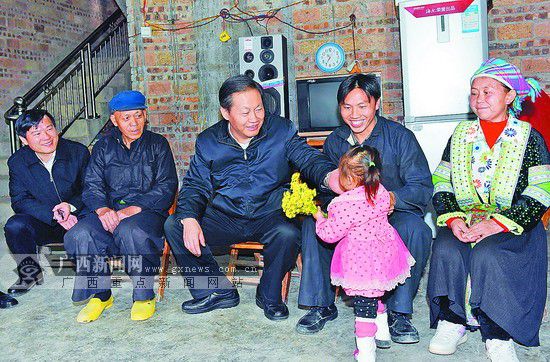Local Party chief tackles roots of poverty with precision
china.org.cn / chinagate.cn by Chen Boyuan, December 7, 2015 Adjust font size:
 |
|
Peng Qinghua (C), Party Chief of south China's Guangxi Zhuang Autonomous Region visits a village in Napo County, on Feb. 13, 2015. [gxnews.com.cn] |
Chinese President Xi Jinping, urged continuous efforts in poverty alleviation, and required that "no ethnic group or region should be left behind" when addressing the annual NPC session held last March.
Peng Qinghua, Party Chief of south China's Guangxi Zhuang Autonomous Region, followed the instruction and visited many impoverished villages in Guangxi that led to the production of an investigation report offering insights in terms of pinpointing the cause of poverty and the measures needed to tackle the problem.
Inconvenient traffic, poor housing conditions and insufficient resources are similarities shared by all poverty-stricken places.
Luocheng Mulao Ethnic Autonomous County in Hechi City of Guangxi is listed in national poverty alleviation program. The county has a population of 380,000, including more than 10,000 designated as living in poverty.
People in the local Cotton Village said inconvenient traffic affected their income from pork sales as pork prices tend to be at least 1-2 yuan (16-32 U.S. cents) per kg higher in villages with cement-paved road. Families in the village are only linked by dirt roads, and children have to walk more than one hour to go to school beyond a mountain each day, Peng's report said.
Local poverty is also reflected in the poor residential housing conditions, such as mixed habitation, where the people and their livestock share the same space. In such houses, people live on the upper floor and livestock on the lower, separated only by a wooden floor. Even so, many houses are in disrepair with severe damage to the walls, roof and pillars. Villager Wu Tianneng is among those living in the worst conditions. His 77-year-old mother has to live in the same room with the pigs they raise.
Peng's report found the impoverished villages he visited lacked manpower. In Zhaizhou Village, half of the young and middle-aged people, or one in every household on average, were seeking better employment elsewhere. Children are left in the care of their aged grandparents who are confined to the village due to limited working capacity. Without enough labor force, aging, sickness and the lack of skills and arable land in combination cause the continuous poverty.
Also due to poverty, many men could not afford to marry, as women from other villages were unwilling to face such a difficult life while local women are already gone.
Through field research, the Party chief learnt that better infrastructure, industrial development, public services and above all, early relocation, are the common desire of local impoverished people.
In quick response, Peng Qinghua realized that poverty reduction in the places he visited and beyond would require differentiated measures, and grass-root Party organizations would be equally important in ensuring good effects.
He came up with what he called "precise measures for poverty alleviation" backed up by a set of rational assessments that cover a household total income, housing, land, working labor and even the education of children.
The assessment process was mainly conducted by officials from other places and was only assisted by local village leaders. This approach proved more efficient than having villagers report their own level of poverty only based on cash incomes. Outsiders were also disinterested in the complicated local interpersonal relations, leading to more convincing results.
Peng also called on grass-root Party organizations to play a leading role in helping impoverished people help themselves. "Government's emphasis in poverty alleviation cannot replace village-based Party organizations' leading role, nor impoverished people's own efforts," he said in the report.
Through years of effort, poverty alleviation in Guangxi has seen preliminary achievements. By the end of 2014, the number of poverty-stricken people fell to 5.38 million from 10.12 million in 2010, and the poverty rate came down to 12.6 percent from 23.9 percent during the same period.
But the above-mentioned Cotton Village is only one of the 5,000 poverty-stricken villages in the entire autonomous region. To meet the target to eliminate poverty by 2020, the regional authority in Guangxi will have to lift at least 800 villages, along with 900,000 people out of poverty each year. That is a major undertaking, said Peng.